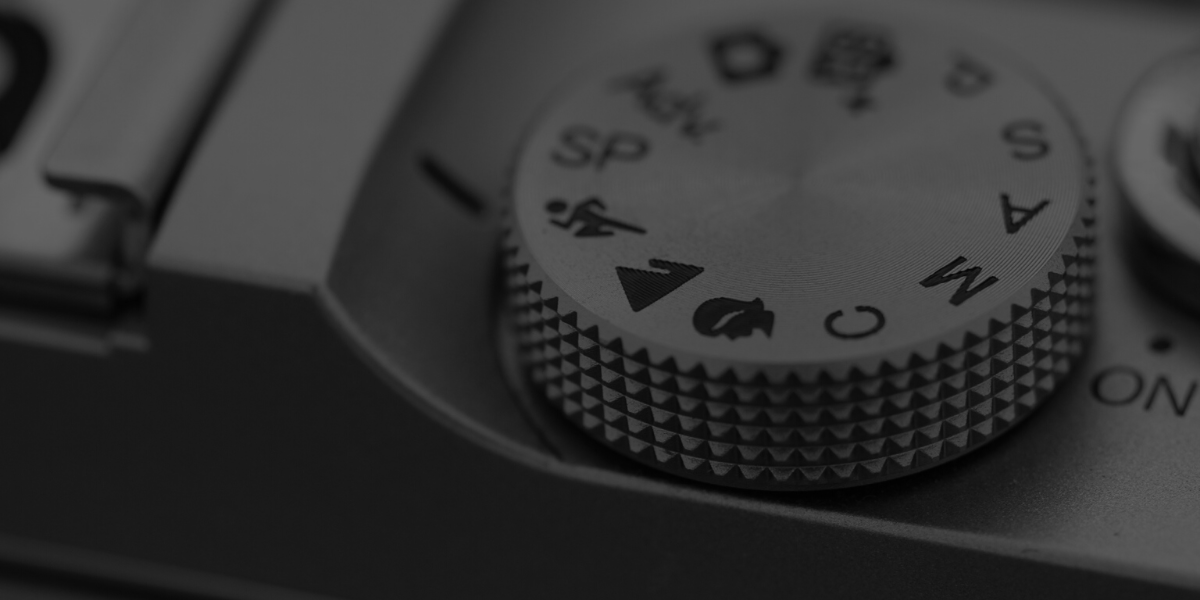In part 2 of this photography basics series, we learned about aperture, ISO, and shutter speed. Now, you need to learn how to apply these settings on your camera to take advantage of your new-found knowledge.
The Great Flaw of Shooting “Icon Modes” on Your Camera
Whenever I teach shooting modes, I always get the same question from members of my class. “Why do I need to learn how to set my camera's settings manually when my camera already has built-in modes for sports, portraits, landscapes, etc?” By the way, these are referred to by photographers as the icon modes because they have icons of the shooting situation on the mode dial.
This example will help to explain why these icon modes won't work for those who want to become a “real” photographer.
With your new photography skills and your new fancy camera, your family members nominate you the official photographer at your family reunion. It comes time to take the giant group picture with over 60 people in it. What mode do you set the camera to? The little portrait icon, because it's a portrait, right?
There is a problem with that; a really big problem. The portrait mode on your camera automatically makes the aperture really low, because it thinks you want shallow depth-of-field in your portrait. But in this instance, it's such a large group of people that you need full depth-of-field so that the people in the back aren't out of focus. The camera doesn't know your intentions with this portrait, so half of the group looks blurry.
And thus we see why the little automatic icon modes (the landscape, portrait, sports modes, etc), simply will not work for photographers who want to learn to take professional-quality photos.
What are Creative Modes?
The Creative Modes on your camera are Program, Aperture Priority, Shutter Priority, and Manual Mode. On most cameras, they are marked “P, A, S, M.” These stand for “Program Mode, Aperture priority, Shutter Priority, and Manual Mode.”
If you use a Canon DSLR, then you'll see that your camera company likes to feel “special” by changing up those names. Canon cameras will show “P, Av, Tv, M” for the same exact modes. “Av” is Canon's version of Aperture Priority, and “Tv” is Canon's version of Shutter Priority.
It may feel a little bit intimidating to move to these creative modes on your camera, but I'll walk you step-by-step through each of the creative modes, how to use them, and what they do.
Program Mode (P)
Just trust me on this one–you don't want to use it–ever.
But just in case you're curious, program mode usually (it is slightly different on each camera model) sets the aperture and the shutter speed for you, and allows the photographer to set the white balance, ISO, and flash.
This mode is not a great choice for serious photographers because you can't set the shutter speed to make sure the picture isn't blurry. Also, you can’t set the aperture to control the depth-of-field.
Aperture Priority Mode
(“A” on most cameras, “Av” on Canon)
I'd love to see you use aperture priority for 95% of your shooting for the next several months. It is the mode that most hobbyist photographers and even many pro photographers shoot in most of the time.
When you shoot aperture priority mode, you set the aperture (the f-stop) and also the ISO. The camera will then set a shutter speed for you so that the picture is properly exposed.
Aperture priority mode is powerful because it is amazingly simple to use, and still allows the photographer a lot of creative choice. In fact, most competent photographers use aperture priority mode every single day.
Suppose you're shooting friends and family at a party. The background is really busy with people and things around the house, so you decide you want a blurry background in the photo (shallow depth-of-field). To achieve this, you set the camera to f/3.5 which is a low aperture and which will blur out the background.
The first picture you take is of a person sitting on the couch next to a lamp. The lamp is bright, so you want a fast shutter speed to get the correct exposure since your aperture is wide open. Using aperture priority mode, the camera would automatically set that shutter speed for you. Then, you want to take a picture of someone in a darker corner of the room. You wouldn't have to fiddle with camera settings at all, because the camera will automatically see that it is dark and choose a slower shutter speed. All the while, you're able to keep the aperture set to use creative depth-of-field.
If I could only teach you one thing in this photography basics series, it would be to set your camera in aperture priority for the next six months.
When you want full depth-of-field, choose a high f-stop (aperture). When you want shallow depth of field, choose a lower f-stop. Your pictures will DRAMATICALLY improve when you learn to control the depth-of-field.
Shutter Priority Mode
(“S” on most cameras, or “Tv” on Canon cameras)
Shutter priority mode sounds very useful, but the truth is that I have never found a professional photographer who uses it. It is a bit difficult to explain why that is.
At first blush, it sounds convenient to have a mode where you could choose the shutter speed and ISO and let the camera choose the aperture for you. For example, when shooting a school basketball game, you might think you'd want shutter priority mode because you could set the shutter speed fast enough for the quick-moving sports situation.
However, you might be surprised to learn that nearly all professional sports photographers I've worked with shoot in aperture priority mode. Why? Because the depth-of-field is key. We want to control depth-of-field in our sports pictures and we just keep an eye on the shutter speed to make sure the camera isn't picking one that is too low. If it does, then we boost the ISO so that the camera will choose a faster shutter speed.
Manual Mode (“M”)
When I was 16 and drove a car for the first time, my teacher took me to a large parking lot. He asked me to floor it as fast as I possibly could across the parking lot. This was my first time driving! So, I went for it. I felt like I was FLYING! Then, he told me half way across the parking lot to look at the speedometer. I was only going 10 miles per hour (16 kilometers)! The point is, the first time you try anything, it feels intimidating and like you're out of control.
The first time any of my students use a camera in manual mode, I can see them terrified to try it out. However, shooting in manual mode really isn't as difficult as it may seem.
To understand manual mode, the example below will be helpful.

I took the picture above while at a photography conference in San Francisco. In a situation like this, the bridge isn't going anywhere, the bay isn't going anywhere, the chain in front of me wasn't going anywhere. I had a captive audience to say the least.
In situations like this, I always use manual mode. I then set my shutter speed to 1/100. I set my ISO to 100 because I wanted no noise in the picture and I knew if I needed more light, I could just slow down the shutter speed.
After taking the picture with the settings above, I realized that the picture came out a bit too dark with 1/100 shutter speed. So, I slowed it down to 1/60 and it looked just how I wanted.
The point is that, eventually, you'll find yourself wanting to shoot in manual mode for situations where you aren't rushed to get the shot. If you're shooting sports, outdoor portraits, or other things, then aperture priority is simpler and faster than shooting in manual mode.
But since you're still learning, the best option for the next few months is to get comfortable shooting in aperture priority mode 100% of the time.
In the next lesson in this series, you're going to learn how you can dramatically improve your pictures by using creative compositions. We're past most of the technical stuff for now.
Next, I'm going to teach you how to develop strong compositions in your photos.




Hi Jim,
Your article is amazing. At first I had lost my confidence with my DSLR but then I feel so comfortable now and less terrified. Thanks for the simple guide, keep it up!
Thank you so much for this article! It’s the first to not leave me in a state of confusion and frustration!
Very well explained… Could u also try and answer one of my queries…i am new to photography and am planning to buy Nikon d5300… I see from reviews it says that people have found it hard to keep the shot stable with this camera…is there any lens to overcome this.
Also, say if I was shooting in humid weather or winter will the lens go foggy/ blurr..and if it does how to correct it….or how to avoid this situation.
How to choose a camera for begginer someone recommended Canon EOS Rebel T5I dslr
So good to read and so easy to understand your information on using a camera , like a lot of others l was lost when using the manual mode , cheers from Australia
Thank you ?
Your posts are indeed very helpful, photography is broad, its not something one can learn in day but your way seem explicit and clear, i mean your approach makes it seem so simple.
Respect!
Hello and thank you for this useful information! I just wanna to add something to the “Shutter priority” mode. I used this mode when I used to go in the late evening to take night shuts from the city. As you know, in the late evening, when is dark outside, we need a high shutter value(more seconds). So I used to mount the camera on the tripod, I set the camera on the shutter priority mode, and sometimes I used values like 7 seconds.
Sir what is important 1,2,3 wise ISO,shutter speed,aperture
Hello,
I’m just a beginner in photography. I’ve decided to buy a DSLR. Can you suggest me some good models to begin with ?
I have pinned and saved all of this. You explain things so well. I just got my first DSLR and am totally lost with the whole Iso in relation to shutter speed! This is so helpful! I am going to read and re-read it! I also feel much better about AV mode.
anyone now how to get mods for bo2?
Excellent article and really helpful. Thank you
Thank you. As a sports photographer I shoot both manual and aperture priority. Aperture priority if I want to emphasize the action on the field at f2.8, ISO 6400. But there are times, when there is a lot going around along the sideline, like a coach giving instructions to the defense team, I would shoot manual with auto ISO because I don’t need the noise that comes with ISO 6400. Shoot manual gives me the flexibility to control the depth of field and the speed required for subjects “that is not going anywhere”.
For beginners, what should the default shutter speed be when shooting in Av mode? Because i am confused.
I truly like your logic and the easy way you explain things; to me this is so helpful and easy to understand (i want to think intelligent minds do think alike). I bought a Sony A6000 not long ago as my first attempt to take decent pictures. The interest is there but I lack the knowledge and experience. thank you
Awesome it proved out to be really helpful ,THANKS
I have to disagree with you. The biggest problem young photographers have is sharpness, and the major cause of unsharp pictures is camera shake caused by a shutter speed too low to hand hold. As such, I teach my students to shoot in shutter priority and set the speed at or above the inverse of the focal length of the lens. Depth of field is rarely a problem, but fuzzy pictures wreck a lot of otherwise good shots — especially those shot in aperture priority with a small aperture. Shallow DOF in sports shooting is usually created with long focal length. Again, the problem with sports is camera shake.
Hi! I am a beginner and just recently purchased a Sony DSCR-h300. There is no A mode, only an M and P mode. If I am taking pictures, should I kust use the manual mode so I can control aperture and use a faster shutter speed? Thanks!
I am convinced that you are a great photographer and an even better teacher!!! Thank you! ??